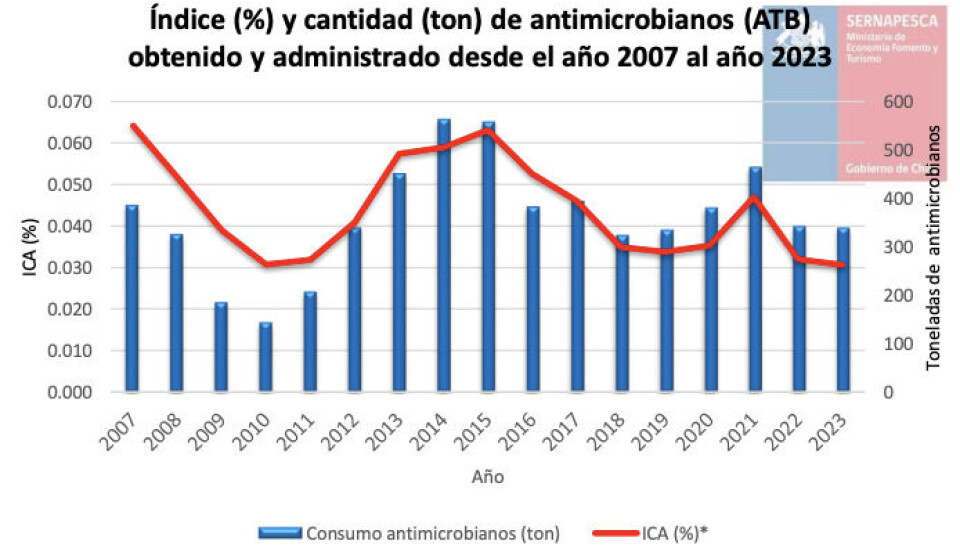
Antibiotic consumption in chilean salmon farming reaches its lowest value in 12 years
The antibiotic consumption index (ICA) of Chilean salmon farming in 2023 reached a value of 0.031, the lowest value since 2011. Additionally, 213,324 tons have been certified under the PROA program.
Sernapesca published yesterday the Report on the Use of Antimicrobials and Antiparasitics in National Salmon Farming, which contains the information corresponding to the year 2023. This corresponds to the traditional report of the Service on the use of antimicrobials, but now uniquely includes information on the antiparasitics used in the industry.
"This is the first report that contains the consumption of antiparasitics in a closed cycle, detailed both by company and by grouping of salmon farming concessions (ACS), which allows us to advance in the implementation of Law 21.532, being a milestone for active transparency in our country because it sets new standards in aquaculture," commented the National Director of Sernapesca, Soledad Tapia Almonacid.
Antibiotics
The published data indicate that the use of antibiotics in salmon farming in 2023 decreased by 0.8%, compared to the previous year, reaching 338.9 tons of active ingredient. This figure is the lowest in the last 3 years. It is worth remembering that comparing 2021 vs. 2022, salmon farming had already achieved a 26% reduction in the total tons of active ingredient, reaching an Antimicrobial Consumption Index (ICA%) of 0.032.
On this occasion, despite reaching a historic 1,107,109 tons of harvested fish, the ICA decreased to 0.031, a 3.1%, the lowest value in 12 years.
Of the total amount of antimicrobials used by the activity during 2023, 98.2% was administered in the sea phase and 1.8% in the freshwater phase. In the freshwater phase, 57.8% corresponded to oxytetracycline and 41.5% to florfenicol. While in the sea water phase, 95.5% corresponded to florfenicol and 3.8% to oxytetracycline.

For the freshwater cultivation phase, of the total antimicrobials administered according to disease, 42.1% was used to treat renibacteriosis, and in seawater, 93.2% of the administered antimicrobials were for the control of piscirickettsiosis.
Antiparasitics
As mentioned, for the first time this information includes data on the consumption of antiparasitics (ICA) per closed production cycle for the year 2023. For the calculation of the ICA, the amount of active ingredient used during the cycle, dead biomass, and harvests made are considered.
The Service highlighted that due to the difference in usage volumes and their lower environmental risk, due to rapid decomposition into water and oxygen, a specific indicator was generated for hydrogen peroxide (H2O2) and another for the rest of the antiparasitics used (azamethiphos, emamectine benzoate, cypermethrin, deltamethrin, and hexaflumuron).
In a universe of 318 closed cycles during the year 2023, 5,840.45 tons of hydrogen peroxide and 5.47 tons of other antiparasitics were used. From a total of 1,076,627.69 tons harvested, and 51,438.24 tons of dead biomass, the national ICA for H2O2 was 5,150.84 g/t and 4.85 g/t for other antiparasitics.
Read the full report here.





















